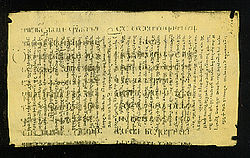The Material and the Immaterial
Stephen STEAD, | June 2, 2021, 08 am
A type of Cultural Heritage object that frequently needs to be recorded is the letter or similar manuscript. Recording should be straightforward: here is a piece of paper, vellum, or other carrier, with some ink on it; it was written by someone and intended for a particular recipient. Easy! But hang on, if it is written on a piece of parchment that has been used, scraped clean and reused and we say this object was created by the person who wrote the latest text we miss the ability to document the person who scraped the parchment clean and the details of the previous use of the parchment without confusing the latest actor with previous ones. In addition, how do we document a transcription of either the latest or the earlier text(s) and then their translations.

A Georgian palimpsest from the 5th or 6th century
(source www.opentext.ge- https://commons.wikimedia.org/wiki/File:Georgian_paliphsest_V-VI_cc.jpg Accessed 2021-05-28)
My preferred solution is to divide the documentation of the object into two parts: the material (parchment) and the immaterial (the text(s)). The history of the physical parchment can then include events for its original manufacture, use, cleaning, and subsequent reuse (as many times as reflects its history). Each event can have actors involved and be dated either absolutely (carbon dating of the parchment or dates in letters) or relatively (this cleaning/reuse is before this use). The history of each of the texts (if there is more than one) would include their creation, including the actors involved and the carrier it was created on; and then the derivatives created from them. The derivatives might include transliterations, translations and reproductions on different carriers.
To achieve this your recording approach must have the ability to record both the material and immaterial components as well as the key “carried by” relationship. My preference is to use the CIDOC Conceptual Reference Model (CIDOC CRM, ISO21127), which has just had a new version released (version 7.1.1 May 2021). This leaner and richer version is the topic of a training workshop at CHNT 26 in November 2021: perhaps I will see you there?


